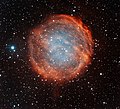File:Planetary Nebula PuWe 1 (noao-puwe1).tiff
From Wikimedia Commons, the free media repository
Jump to navigation
Jump to search

Size of this JPG preview of this TIF file: 659 × 599 pixels. Other resolutions: 264 × 240 pixels | 528 × 480 pixels | 845 × 768 pixels | 1,126 × 1,024 pixels | 2,253 × 2,048 pixels | 8,372 × 7,612 pixels.
Original file (8,372 × 7,612 pixels, file size: 154.28 MB, MIME type: image/tiff)
File information
Structured data
Captions
Captions
This image was obtained with the wide-field view of the Mosaic camera on the Mayall 4-meter telescope at Kitt Peak National Observatory. PuWe 1 is one of the largest and faintest planetary nebula known to exist.
Summary
[edit]| Warning | The original file is very high-resolution. It might not load properly or could cause your browser to freeze when opened at full size. | Open in ZoomViewer |
|---|
| DescriptionPlanetary Nebula PuWe 1 (noao-puwe1).tiff |
English: This image was obtained with the wide-field view of the Mosaic camera on the Mayall 4-meter telescope at Kitt Peak National Observatory. PuWe 1 is one of the largest and faintest planetary nebula known to exist. The nebula was created when a red giant star blew off its outer layers near the end of its life. The gas is energized by the remaining core of the star, which is called a white dwarf. However it is very faint due to its large size. As planetary nebulae expand they become fainter because the gas moves further from the white dwarf that energizes it. The image was generated with observations in Hydrogen alpha (red) and Oxygen [OIII] (blue) filters. In this image, North is left, East is down. |
| Date | 30 June 2020, 21:34:00 (upload date) |
| Source | Planetary Nebula PuWe 1 |
| Author | T.A. Rector (University of Alaska Anchorage) and H. Schweiker (WIYN and NOIRLab/NSF/AURA) |
| Other versions |
|
Licensing
[edit]This media was created by the National Optical-Infrared Astronomy Research Laboratory (NOIRLab).
Their website states: "Unless specifically noted, the images, videos, and music distributed on the public NOIRLab website, along with the texts of press releases, announcements, images of the week and captions; are licensed under a Creative Commons Attribution 4.0 International License, and may on a non-exclusive basis be reproduced without fee provided the credit is clear and visible." To the uploader: You must provide a link (URL) to the original file and the authorship information if available. | |
This file is licensed under the Creative Commons Attribution 4.0 International license.
| |
File history
Click on a date/time to view the file as it appeared at that time.
| Date/Time | Thumbnail | Dimensions | User | Comment | |
|---|---|---|---|---|---|
| current | 18:48, 17 September 2023 |  | 8,372 × 7,612 (154.28 MB) | OptimusPrimeBot (talk | contribs) | #Spacemedia - Upload of https://noirlab.edu/public/media/archives/images/original/noao-puwe1.tif via Commons:Spacemedia |
You cannot overwrite this file.
File usage on Commons
There are no pages that use this file.
Metadata
This file contains additional information such as Exif metadata which may have been added by the digital camera, scanner, or software program used to create or digitize it. If the file has been modified from its original state, some details such as the timestamp may not fully reflect those of the original file. The timestamp is only as accurate as the clock in the camera, and it may be completely wrong.
| Image title | This image was obtained with the wide-field view of the Mosaic camera on the Mayall 4-meter telescope at Kitt Peak National Observatory. PuWe 1 is one of the largest and faintest planetary nebula known to exist. The nebula was created when a red giant star blew off its outer layers near the end of its life. The gas is energized by the remaining core of the star, which is called a white dwarf. However it is very faint due to its large size. As planetary nebulae expand they become fainter because the gas moves further from the white dwarf that energizes it. The image was generated with observations in Hydrogen alpha (red) and Oxygen [OIII] (blue) filters. In this image, North is left, East is down. |
|---|---|
| Width | 8,372 px |
| Height | 7,612 px |
| Bits per component |
|
| Compression scheme | LZW |
| Pixel composition | RGB |
| Orientation | Normal |
| Number of components | 3 |
| Number of rows per strip | 10 |
| Horizontal resolution | 72 dpi |
| Vertical resolution | 72 dpi |
| Data arrangement | chunky format |
| Software used | Adobe Photoshop CS6 (Macintosh) |
| File change date and time | 12:03, 11 May 2015 |
| Color space | sRGB |

